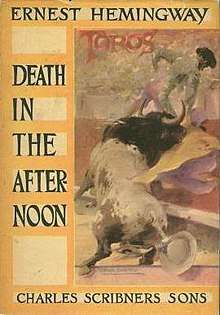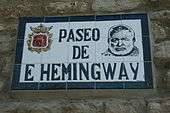Death in the Afternoon
Death in the Afternoon is a non-fiction book written by Ernest Hemingway about the ceremony and traditions of Spanish bullfighting, published in 1932. The book provides a look at the history and what Hemingway considers the magnificence of bullfighting. It also contains a deeper contemplation on the nature of fear and courage. While essentially a guide book, there are three main sections: Hemingway's work, pictures, and a glossary of terms.
 Book cover with color facsimile of "The Bullfighter" by Roberto Domingo. | |
| Author | Ernest Hemingway |
|---|---|
| Cover artist | Roberto Domingo |
| Country | United States |
| Language | English |
| Subject | Bull-fighting |
| Genre | Travel literature |
| Publisher | Charles Scribner's Sons |
Publication date | 1932 |
| Pages | 517 |
Contents
In recent times, Bullfighting has become a topic of heated controversy. Toward that end Hemingway commented, "anything capable of arousing passion in its favor will surely raise as much passion against it."[1]
The chances are that the first bullfight any spectator attends may not be a good one artistically; for that to happen there must be good bullfighters and good bulls; artistic bullfighters and poor bulls do not make interesting fights, for the bullfighter who has ability to do extraordinary things with the bull which are capable of producing the intensest degree of emotion in the spectator but will not attempt them with a bull which he cannot depend on to charge...
— Ernest Hemingway, from Death in the Afternoon[2]

Hemingway became a bullfighting aficionado after seeing the Pamplona fiesta in the 1920s, which he wrote about in The Sun Also Rises.[3] In Death in the Afternoon, Hemingway explores the metaphysics of bullfighting—the ritualized, almost religious practice—that he considered analogous to the writer's search for meaning and the essence of life. In bullfighting, he found the elemental nature of life and death.[3] Marianne Wiggins has written of Death in the Afternoon: "Read it for the writing, for the way it's told... He'll make you like it [bullfighting]... You read enough and long enough, he'll make you love it, he's relentless".[4]
In his writings on Spain, Hemingway was influenced by the Spanish master Pío Baroja. When Hemingway won the Nobel Prize, he traveled to see Baroja, then on his death bed, specifically to tell him he thought Baroja deserved the prize more than he. Baroja agreed, and something of the usual Hemingway tiff with another writer ensued, despite Hemingway's original good intentions.[5]
Death in the Afternoon was published by Scribner's on 23 September 1932 to a first edition print run of approximately 10,000 copies.[6]
Notes
- Hemingway 2003: p. 12, "It would be pleasant of course for those who do like it if those who do not would not feel that they had to go to war against it or give money to try to suppress it, since it offends them or does not please them, but that is too much to expect and anything capable of arousing passion in its favor will surely raise as much passion against it."
- Hemingway 2003: pp. 12–13
- Meyers 1985, pp. 118–119
- Wiggins, Marianne (1984). Separate Checks. New York: Random House. p. 148. ISBN 0-394-53255-4.
- Meyers 1985, p. 512
- Oliver, p. 75
References
- Hemingway, Ernest (2003) [1932]. Death in the Afternoon (1st Scribner trade pbk. ed.). New York, New York: Charles Scribner's Sons. ISBN 978-0-684-80145-2. OCLC 53453017.
- Baker, Carlos (1972). Hemingway: The Writer as Artist (4th ed.). Princeton University Press. ISBN 0-691-01305-5.
- Meyers, Jeffrey (1985). Hemingway: A Biography. London: Macmillan. ISBN 0-333-42126-4.
- Mellow, James R. (1992). Hemingway: A Life Without Consequences. New York: Houghton Mifflin. ISBN 0-395-37777-3.
- Oliver, Charles M. (1999). Ernest Hemingway A to Z: The Essential Reference to the Life and Work. New York: Checkmark. ISBN 0-8160-3467-2.
- "Death in the Afternoon – A Literary Cocktail" Retrieved July 4, 2010.
External links
- Death in the Afternoon at Faded Page (Canada)
- Hemingway Archives, John F. Kennedy Library